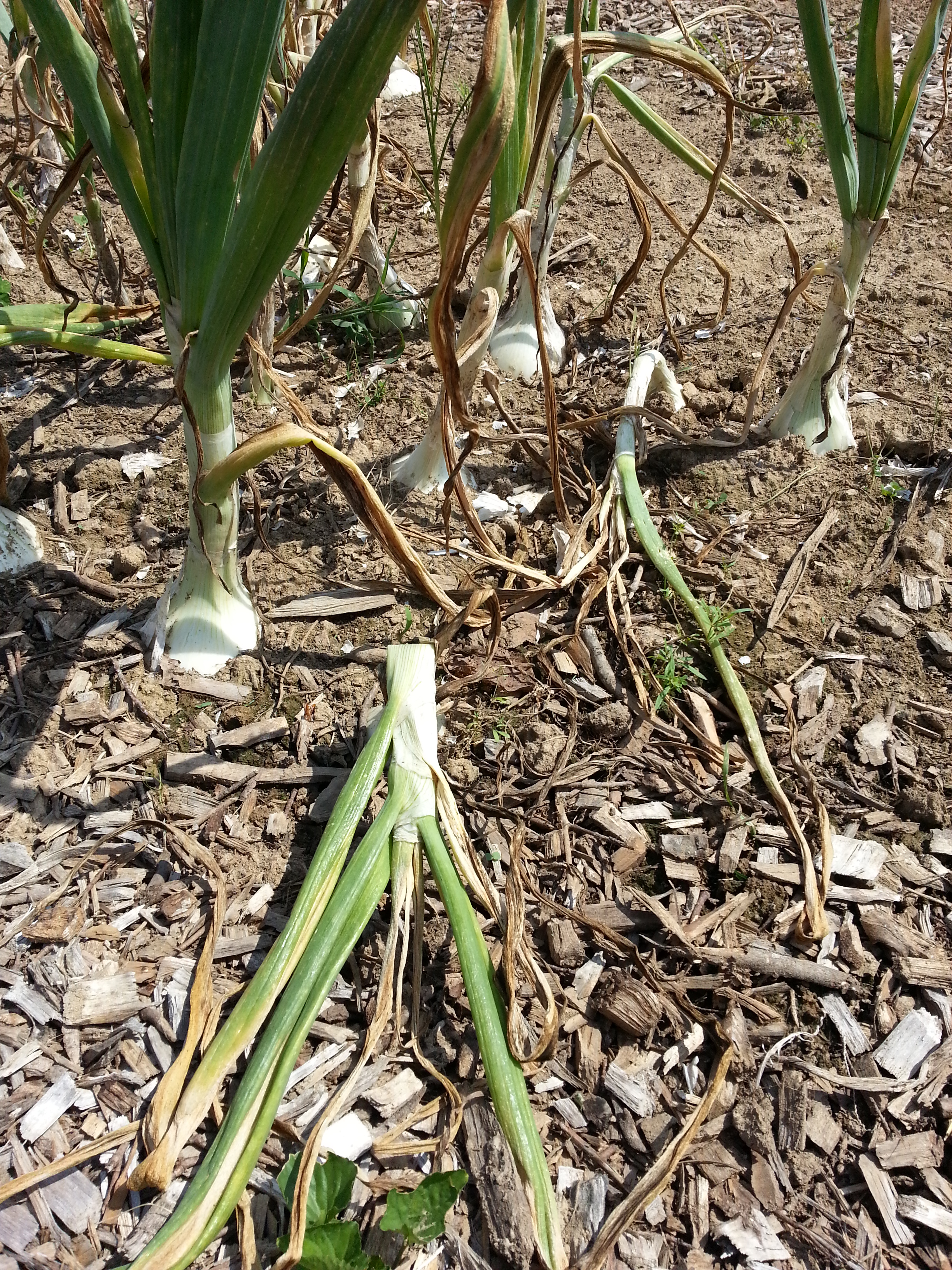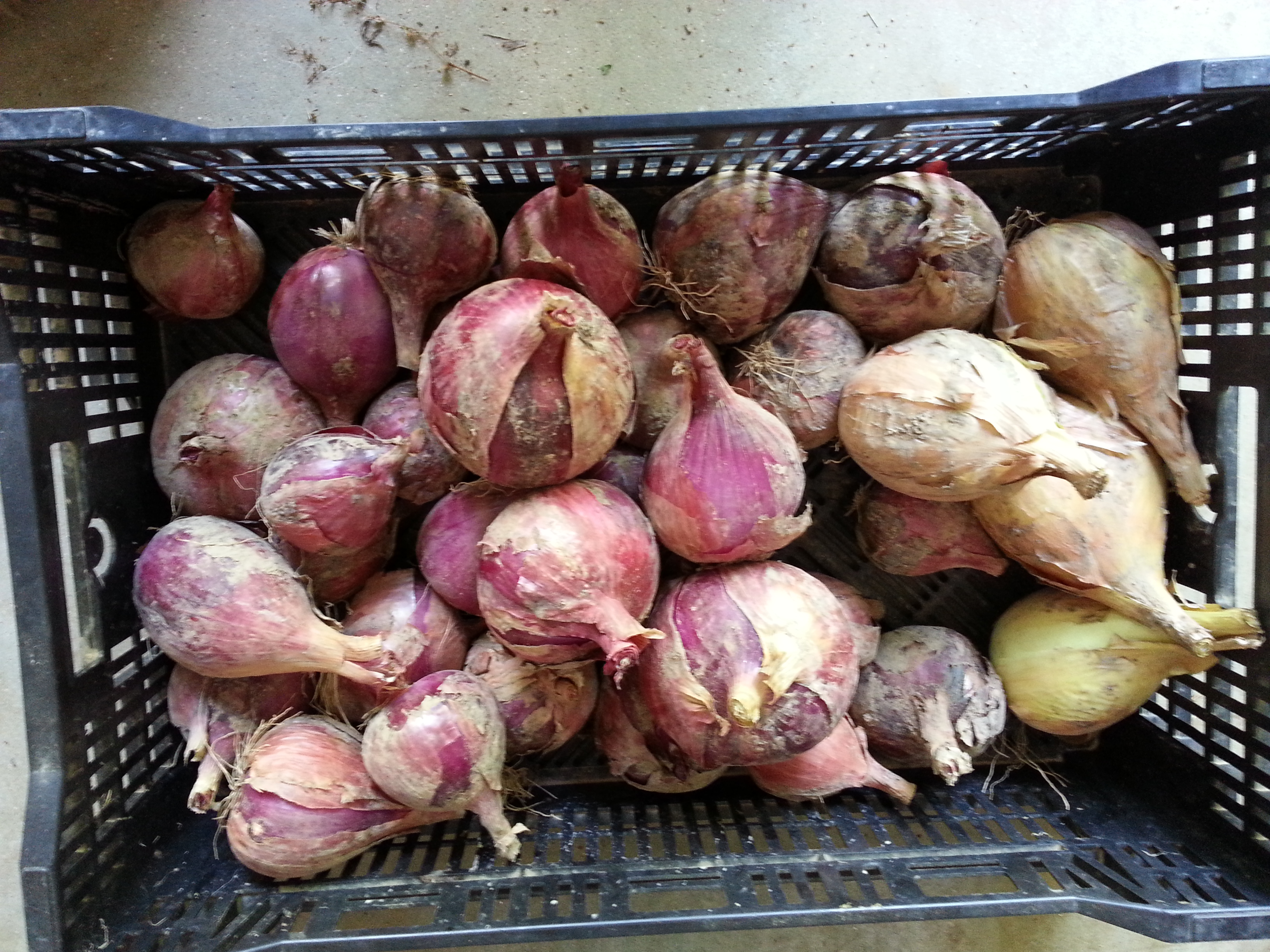 We harvested some fantastic looking “Red Candy Apple’ purple onions a few weeks ago and it is now time to start digging some ‘Yukon Gold’ potatoes and garlic over the weekend; I am so excited about the garden this year because it is performing so well! We need to wait another week or so to harvest the ‘Sterling’ and ‘Walla Walla’ onions because tops have yet to flop over…. this allows them to store better. We have enjoyed some fresh green onions and bulbs, but for the bulk of the crop we to want harvest and cure them properly so they will store well.
We harvested some fantastic looking “Red Candy Apple’ purple onions a few weeks ago and it is now time to start digging some ‘Yukon Gold’ potatoes and garlic over the weekend; I am so excited about the garden this year because it is performing so well! We need to wait another week or so to harvest the ‘Sterling’ and ‘Walla Walla’ onions because tops have yet to flop over…. this allows them to store better. We have enjoyed some fresh green onions and bulbs, but for the bulk of the crop we to want harvest and cure them properly so they will store well.
Potatoes, garlic and onions are staples worldwide partly because of their versatility and partly because of their storage-ability. Late July and August is when our spring planted onions, garlic and potatoes reach maturity and are ready for harvest. If you want to harvest some new potatoes, onions or garlic before they reach maturity enjoy them at the table in short order but if you want to store them it is important to harvest them at the correct time. Check your seed packet or variety information for details about how many days are expected for maturity, some varieties may be later.
Garlic is the easiest in my experience. Wait for the tops to die back completely and then pull up your crop. If you harvest them green you will find that the cloves have not fully formed so a complete die-back it critical. Leave them intact and lay them over a screen, or some similar device, for about 1-2 weeks in a shaded well-ventilated location (I use the garage). Once the bulbs feel dry braid them all together or cut the stems leaving a couple of inches above the bulb and store in a mesh bag. A cool, dark storage space with good ventilation is ideal.
The signal that your onions are ready for harvest can be seen above the soil, as well. The tops of the plants will begin to flop over and die back. Once about half of the tops have turned brown and flopped over the onion are at their peak for harvesting. You don’t want to harvest too early because the bulb size will be small, they will cure slowly and will be more likely to decay before you use them. Putting off harvest too long also increases the chances of decay. Once the tops flop and have died out, dig the onions.
During the curing process, you want to cut the tops back to about 2 inches and lay them out on a screen in that same dry, well-ventilated, shaded place your garlic enjoyed for about 2 weeks. I turned a fan on in the garage this year because of high humidity. As they cure the necks shrink up and phenolic compounds accumulate there which helps to stop rot. Those onions with thicker necks have a harder time protecting themselves from rot so go ahead and sort those out and use them first. Those that look clean and be can have the remaining tops snipped after 2 weeks of curing. Onions are most successfully stored at 32 degrees with a low humidity level. Rot and sprouting during the bulb’s dormant period are more prevalent when they are stored at temperatures above 40.
Other ways to increase your onion harvest and successful storage is to start with the right variety at planting time. In Kentuckiana we should plant intermediate-day length onions (these onions set bulbs when day-length averages 12-14 hours) including the varieties ‘Super Star’, ‘Candy’, ’Red Candy Apple’, ‘Spartan Sleeper’, ‘Storage King’, ‘Sterling’ and ‘Big Daddy’; and most of these prove to be good storage onions as well. Interestingly, the more pungent the onion the better it stores because of higher levels of the phenolic compound which helps to keep disease down in the bulb. I have great success with Dixondale Onions out of Texas (and poor yields if I buy generic!)
Potatoes, depending on the variety, can be harvested early, mid or late season taking as little as 70 days to maturity up to 135 days, but again, for storage wait until the tops have completely died back. Some gardeners recommend waiting another week or two after this before digging so that the skin has a chance to harden off. If you do not do this then be sure to let them cure once dug.
Sort your potatoes and keep the bruised or cut ones for eating now; set the clean ones aside so they can cure for 1-2 weeks at 65-70 degrees and high relative humidity. Once they are cured they are ready to be stored in a cool, moist, dark place that maintains a temperature between 40-50 degrees (ideally) but who can pull that off all the time. A cool place in the basement will suffice; just don’t refrigerate, it will convert the starch to sugar.

